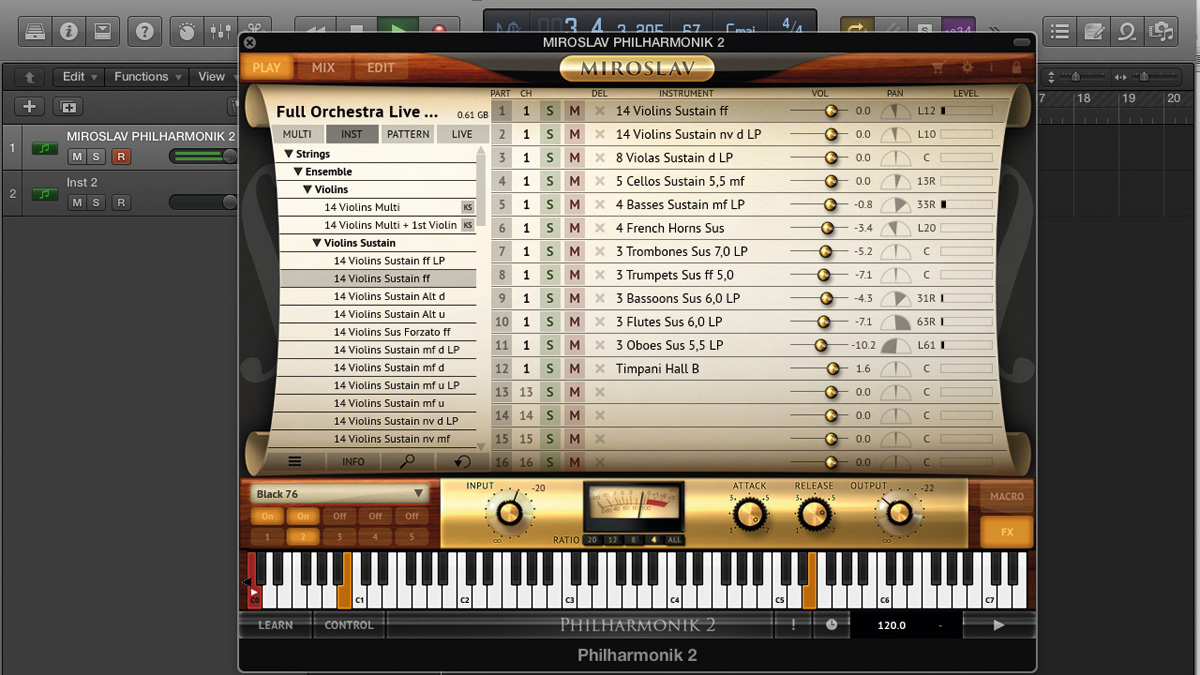MusicRadar Verdict
Things have come on a lot in ten years, and v2 of Miroslav Philharmonik is a hugely powerful one-stop orchestral shop.
Pros
- +
Huge array of articulations with consistent sound quality. Includes the v1 library. Excellent onboard processing in SampleTank 3.
Cons
- -
No new percussion sounds.
MusicRadar's got your back
IK Multimedia's original SampleTank-powered Philharmonik virtual instrument was built on the first library by orchestral sampling pioneer Miroslav Vitous.
It's ten years since it was released, and even longer since the sample set originally became available in other formats. In the meantime, IK has stepped SampleTank up to version 3, delivering a slicker interface, better effects and tons of new sample content.
Phil your boots
Miroslav Philharmonik 2 (VST/VST3/AU/AAX/ standalone) is effectively a custom version of SampleTank 3, and apart from the obvious omission of the drum Pad Screen, it keeps all of SampleTank 3's features in the same locations, albeit with a full graphical makeover.
So, it's a 16-part multitimbral design, incorporating a 16-channel mixer with four dedicated auxiliaries, four dedicated returns and a master output section. Each channel has five insert points, and with 34 effects to choose from, including familiar IK favourites such as the Black 76 1176 emulation and ConvoRoom convolution reverb (with a nice new 3D visualisation page), onboard processing is exceptionally well covered.
The Edit page houses typical sample playback/synthesis options including keyspan, sampling type (Resample, Pitch Shift/Time Stretch or Stretch), filtering, LFOs, velocity response, envelopes and round robin options.
Importantly, there's also a dropdown Element/Articulation selector, which comes in handy when you're editing a preset containing multiple articulations. What you don't get, as expected, is any access to the underlying samples themselves.
Further SampleTank 3 features include Live Sets, for quickly selecting and loading sounds in a live performance setting, and 98 MIDI Pattern Presets, which can be triggered from single keys or dragged into the host DAW for playback and editing.
Well orchestrated
By default, Philharmonik 2 installs its sound library into the SampleTank 3 folder, so if you also have SampleTank 3 installed, the Philharmonik 2 library automatically becomes available there, too, loading in ST3's standard interface.
Philharmonik 2 retains all of v1's sample content and adds a whole new orchestral sample set. Altogether, it weighs in at 56GB on disk (6GB of which is the Philharmonik 1 library) and comprises over 2700 instrument presets.
Like SampleTank 3, it has integrated access to IK's Custom Shop, although any add- on sounds have to be used in SampleTank 3 (which comes with any Custom Shop purchase), as Philharmonik 2 can only load its own library.
The new library includes solo and ensemble instruments and lots of articulations. For multi- articulation instruments, articulations are switched via velocity (VS), key (KS) or mod wheel (MW) - this is indicated in the preset naming, so you always know what you're loading.
The panel just above the keyboard toggles between showing the parameters of the currently selected insert effect and eight Macro controls, which put salient parameters for the current instrument at your fingertips.
You'll also find ten orchestral multis (Full Orchestra, String Ensemble and so on), layering various instruments on one MIDI channel.
Orchestral manoeuvres
The new library is divided into five categories: Strings, Brass, Woodwinds, Chromatic and Piano. The first three are self explanatory, while Chromatic includes harpsichord, marimba, glockenspiel, chimes and vibraphone, and Piano is a concert grand. What you won't find are any new percussion, choirs, guitars or organs, although the old ones are still in the v1 library.
The most obvious improvement to Philharmonik 2 over v1 is its better, more abundant selection of articulations. Looking beyond the multiple articulation instruments (which are perfectly good for the major playing techniques) and heading to the various sub- folders, you'll find instrument presets for most of those individual articulations.
The Ensemble Violins, for example, include 11 articulation sub- folders, offering individual bowing directions, and looped and non-looped patches. Further goodies include played legatos, glissandi, intervals and scales, all of which can be invaluable for emulating real strings. What's more, if you switch to the Stretch sampling engine, any articulation can be retimed to match the track tempo.
Crucially, across pretty much all instruments, the articulations are more sonically consistent than those of Philharmonik 1, again making the process of orchestra emulation considerably simpler.
Other things to mention are the 9-foot Philharmonik Grand piano, which not only sounds great, but includes 'eco' versions that greatly reduce its 1.5GB RAM footprint. We also like the Classical Harpsichord and Concert Marimba, the last offering soft and hard mallet options, and both also available in 'eco' variants.
Given that most orchestral packages are sold as individual sections, the all-in-one nature of Miroslav Philharmonik 2 will be a godsend to those on a budget, as will the inclusion of the v1 library, which provides a full further layer of helpful alternatives. Despite its extensive sonic coverage, though, this is certainly no 'budget' product, delivering the goods on every level with its superb samples and the slick, reliable SampleTank 3 engine. An excellent update.
Computer Music magazine is the world’s best selling publication dedicated solely to making great music with your Mac or PC computer. Each issue it brings its lucky readers the best in cutting-edge tutorials, need-to-know, expert software reviews and even all the tools you actually need to make great music today, courtesy of our legendary CM Plugin Suite.

“Ozzy drove us all nuts with that Moog thing. But the song was great”: How Black Sabbath took a surprise left turn on the classic album Sabotage

“This golden gain machine covers the entire spectrum from gritty boost through to full-on fuzz”: Great Eastern FX’s Focus Fuzz Deluxe has got boost, drive, octave, fuzz... everything going on

It’s time to finally ditch those cables: SonicLink from AlphaTheta is here, and it will most likely change your life











